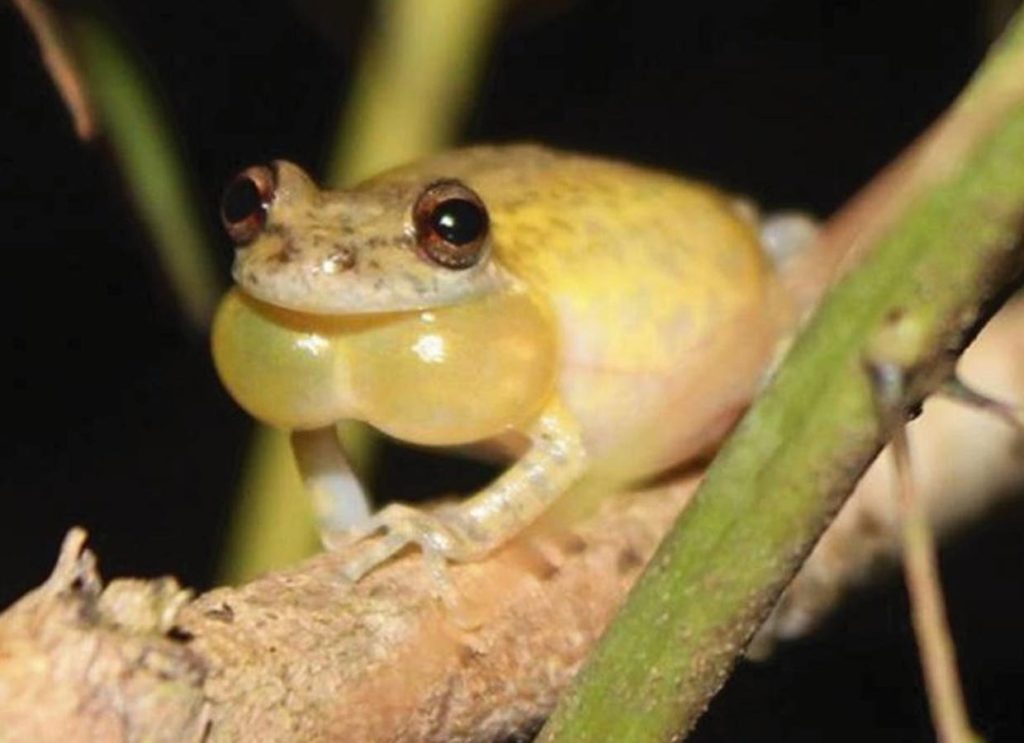A new article published in PLOS ONE documents the existence of a new, color-changing species of snouted treefrog: Scinax juruena. It was discovered from islands within the Juruena River, in the Brazilian state of Mato Grosso, by a team of researchers led by Harvard University’s Miquéias Ferrão.
Here are some of its defining features:
- Scinax juruena changes its appearance from day to night. During the day, it presents as greyish-brown, with spots, blotches and bars on its back. At night, coloring of the head and body changes to a brownish yellow with tiny light brown dots.
- It can be distinguished from other snouted treefrogs by its larger adult body size, its prominent vocal sac, a reddish-brown horizontal stripe on the iris, dark blotches on the vocal sac and the throat of females and its uniformly brown thigh coloring.
- It is known to inhabit forest areas on four small islands in an archipelago of the Juruena River, in the southern Amazonia region.
- It mates during the rainy season, between November and May. “Large choruses of breeding males were found after two or more days of consistently heavy rainfall,” state the researchers. “Males call while perched on shrubs and tiny trunks in or near large ponds formed by river flooding and small ponds formed by accumulation of rainwater in low-lying areas. We found as many as three calling males sharing the same shrub.”
The researchers first documented the new species while surveying islands along the Juruena River between 2019 and 2020. During these surveys, they noticed a snouted treefrog whose mating call and appearance did not resemble any of the currently known species. Subsequent genetic analysis confirmed their assessment in the field—the treefrog was genetically distinct, warranting its recognition as a new species.
Although the researchers also surveyed the mainland forests along both banks of the Juruena River adjacent to the islands inhabited by the new species, no additional populations were found. Therefore, as currently known, the distribution of Scinax juruena is limited to just a few islands with a total combined area of less than one square kilometer.
If this accurately reflects the entire distribution of the new species, Scinax juruena would be classified as “Endangered” according to the International Union for Conservation of Nature Red List Criteria. However, the researchers state that more data is needed to confirm the extent of the new species’ distribution and recommend the species’ conservation status be listed as “Data Deficient” for now.
And, though the species is new to science, it already faces many threats. “The construction of numerous hydroelectric power plants in the region will likely jeopardize the species’ survival,” say the researchers.
Currently, three mega-dams are being planned for construction along the Juruena River, which are likely to disrupt the nature flood cycle that many species associated with the riverine environment rely on, including the newly discovered treefrog.
Furthermore, the region inhabited by the treefrog is already facing environmental pressure from illegal mining, unsustainable agriculture, overfishing and uncontrolled logging.
“We strongly urge Brazilian licensing institutions to conduct environmental impact assessments that include comprehensive sampling of islands in the Juruena River and adjacent regions to evaluate the extinction risk of Scinax juruena and other organisms, and to implement meaningful conservation measures before the river is overwhelmed by hydropower projects,” conclude the authors.
This discovery of this new treefrog highlights how many parts of the Amazonian region are still poorly explored and studied from a biodiversity perspective. New surveys into remote regions of the Amazon continue to reveal many new species. For example, within just this group of treefrogs (genus Scinax), six new Amazonian species were unveiled between 2014 and 2018 during remote field expeditions.
Strikingly, based on the genetic analyses performed in the current study, the researchers also detect as many as eight additional new species of snouted treefrog that still await to be described. In Amazonia, it appears to be an ongoing race between discovery and extinction.
Read the full article here






